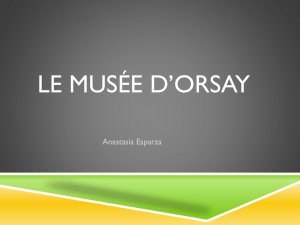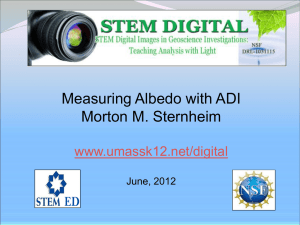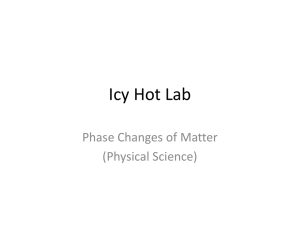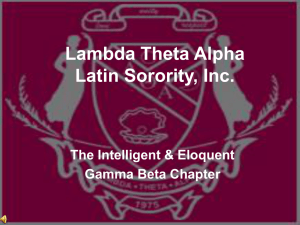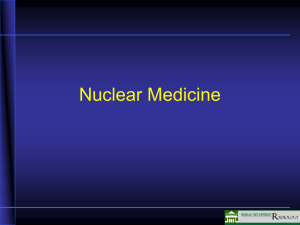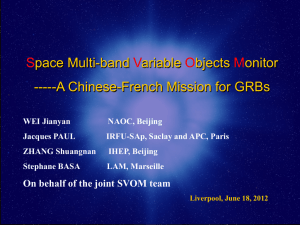SVOM - Indico
advertisement
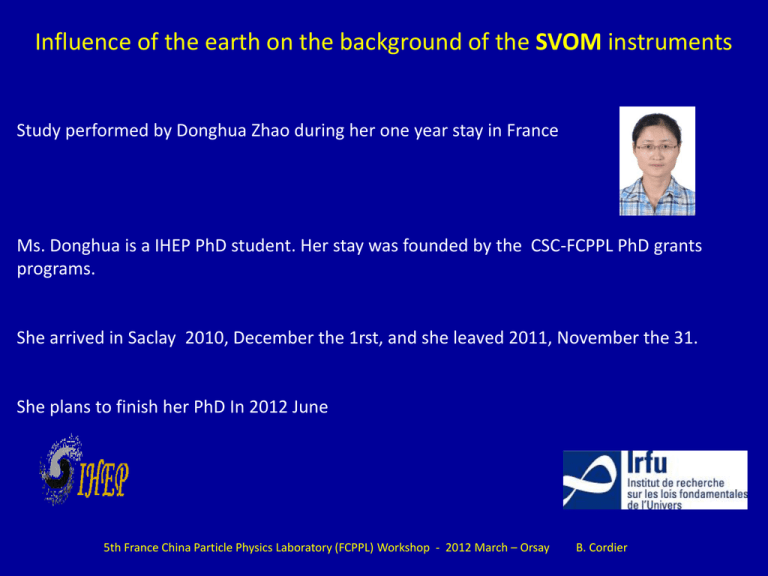
Influence of the earth on the background of the SVOM instruments Study performed by Donghua Zhao during her one year stay in France Ms. Donghua is a IHEP PhD student. Her stay was founded by the CSC-FCPPL PhD grants programs. She arrived in Saclay 2010, December the 1rst, and she leaved 2011, November the 31. She plans to finish her PhD In 2012 June 5th France China Particle Physics Laboratory (FCPPL) Workshop - 2012 March – Orsay B. Cordier The SVOM mission is devoted to the study of Gamma-ray burst It is a french chinese collaboration. The main laboratories involved are: NAOC beijing, IHEP beijing, XIOPM Xian, CEA-Irfu, IRAP Toulouse Launch date 2017 The scientific payload aboard SVOM GRM VT ECLAIRs MXT 5th France China Particle Physics Laboratory (FCPPL) Workshop - 2012 March – Orsay B. Cordier SVOM Pointing Strategy Sun Night side Sun Night side SVOM orbit (i ~ 30°) Sun Night side A pointing close to the antisolar in the night part of the orbit is required in order to permit the fast follow-up of localized GRBs with large telescope on Earth 5th France China Particle Physics Laboratory (FCPPL) Workshop - 2012 March – Orsay B. Cordier SVOM Pointing Strategy At each orbit (every 90 minutes) the Earth enters inside the instruments FOV 5th France China Particle Physics Laboratory (FCPPL) Workshop - 2012 March – Orsay B. Cordier X and gamma ray background issues in a low earth orbit Cosmic protons Cosmic X-ray background The presence of the Earth in the FOV introduces: - An occultation of the diffused X-ray background - A reflection of the X-ray background on the Earth - An albedo component du to cosmic proton interactions in the earth atmosphere In this work we focus on the assessment of the albedo component 5th France China Particle Physics Laboratory (FCPPL) Workshop - 2012 March – Orsay B. Cordier Albedo gamma : computation of the emissivity 1/4 For 1 cm2 of earth atmosphere : dN C = dE E / 44keV 5 + E / 44keV 1.4 ph / cm 3μ 1+ μ 1.47 0.0178 / 2.8 + / 2.8 C= 2 5π Rcut 1+ 0.25 0.4 1.3 1+ 2.5 where, μ = cosθ Rcut = 59.4 1.5 1 0.4 , / s / sr / keV ph / cm 2 / s / sr cos4 λm 1+ 1+ cos λ sinθsinξ 1/ 2 2 3 2 GV m Sazonov et al. 2007 Albedo gamma : computation of the emissivity 1/3 For a given atmosphere cell of 1 cm2, the emissivity depends on: 1 the solar modulation at the epoch of observation 2 the zenithal angle θ of the cell viewed from the spacecraft 3 the rigidity cut off at the cell position 5th France China Particle Physics Laboratory (FCPPL) Workshop - 2012 March – Orsay B. Cordier Albedo gamma : computation of the emissivity 2/4 The spacecraft is moving, it intercepts different atmosphere spherical caps At a given satellite position, one consider a spherical cap We divide the considered cap in elementary cells For each cell we compute Rcut At the end one integrate the emissivity over the spherical cap area. 5th France China Particle Physics Laboratory (FCPPL) Workshop - 2012 March – Orsay B. Cordier Albedo gamma : computation of the emissivity 4/4 Emissivity computed along the SVOM orbit (Inclination 30°) Taking into account the 2015 magnetic field model, the worse position on the SVOM orbit is: Alpha=287°E delta=30°N 5th France China Particle Physics Laboratory (FCPPL) Workshop - 2012 March – Orsay B. Cordier X and gamma ray Background computation versus the position of the earth relative to the instrument field of view Using the previous results we performed Geant4 simulations Hypotheses position on the orbit Alpha=287°E delta=30°N (worse case) Cosmic gamma Reflected cosmic gamma Albedo gamma Conclusions • Donghua Zhao did a very serious work during her stay in Saclay • Thanks to her work, the collaboration is now in a position to compute the X and Gamma ray background and its variation at any time and at each point of the SVOM orbit. • A paper summarizing this work has been submitted to NIM last month (Donghua Zhao et al.) 5th France China Particle Physics Laboratory (FCPPL) Workshop - 2012 March – Orsay B. Cordier
